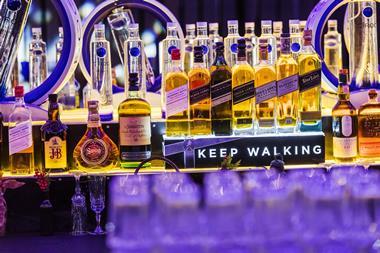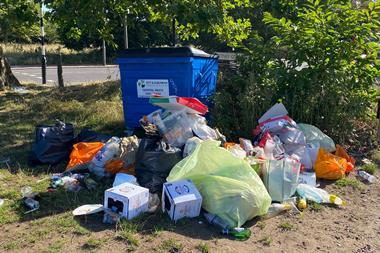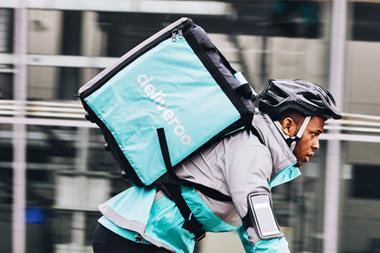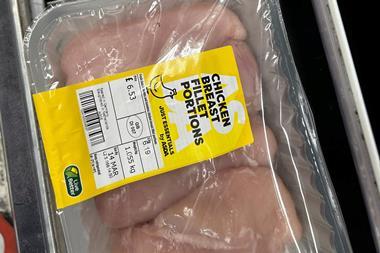Consumers are scrimping and saving, yet premium spirits with hefty price tags are springing up left, right and centre. Graham Holter asks what's going on
Premium spirits should, in theory, be some of the first victims of a recession. Not only are they regarded as frivolous non-essential purchases, they're also exchangeable for cheaper alternatives.
But rather than slumping, the market for these kinds of spirits appears to be buoyant, with a steady stream of new product launches from whisky, vodka and gin makers in recent months (see box).
Brand owners are clearly confident the demand is there - but what's driving it? And can it last?
Certainly, there's evidence to suggest the spirits sector is on the whole thriving. At least that's the situation in the take-home segment, which continues to benefit from the on-trade's general decline. Nielsen off-trade sales figures for the year to 18 April show a spirits sector growing by 7% in value, almost twice as fast as wine's 4%.
Some of that growth can be attributed to duty increases, but spirits were performing well long before the Chancellor's recent hikes.
It's a trend highlighted in a recently published report on the UK spirits market by Mintel, which details the success of premium spirits and vodka in particular.
British consumers have become more interested in ingredients and quality across food and drink categories, driving growth in premium goods with provenance, claims the report. "This has helped to drive demand for premium and super-premium vodkas, which are growing at a faster rate than standard and budget lines, albeit from a much smaller base," it says.
The premium spirits sector is expected to hold up thanks to continued affluence among its target consumer group, according to Mintel. Standard spirits, on the other hand, are the hardest squeezed as the cash-strapped lower socio-economic demographic trades down from branded to budget or own-label varieties.
Mintel calculates that premium vodkas account for at least a third of NPD for the period 2004 to 2008. Its figures show that total UK volumes of premium vodka have risen from 3 million litres in 2006 (4% of the market) to 4.2 million litres in 2008 (5% of the market).
"However," it adds, "premium still represents a niche market in comparison with other markets such as the US, where it accounts for over a fifth of total vodka sales."
The shape of NPD
Brand owners are also reporting solid growth. Gavin Bacon, managing director of Hi-Spirits, which supplies premium brands such as Effen vodka, Blue 10 tequila and Sebor absinth, says his elite brands division is going "in the right direction in 2009 versus 2008".
"It's the mainstream brands that sit in the middle of commodity and premiums that we're taking share from," he explains.
However, Bacon cautions against getting too carried away. He remains unconvinced that much innovation is happening with the actual spirits themselves in some categories . "Particularly in vodka, people are spending £10 on their packaging - doing things like putting crystals on it - just to justify higher prices."
In other spirits categories NPD is focusing on using different blends and playing around with taste profiles. "There are some interesting things happening in whisky and bourbon, but it's really about liquid nuances."
Whether the raft of premium launches will prove their worth is open to debate. Opportunities for premium products to launch into the off-trade remain pretty limited, adds Bacon. "There are a few supermarket chains that would consider stuff like that seriously. The playing field is fairly small. Unless you're a default in the category, something like Grey Goose vodka - which they put on shelf even though they know it's not going to sell huge quantities - the top four multiple grocers don't want to talk to you."
How to make the launch
High-end products are still most effectively seeded and established in stylish bars, says James Rackham, managing director of Emporia Brands.
"I'm a pragmatist, so there are certain occasions when NPD work in the off-trade is appropriate," he says. "But the reality is that the trialling of a premium product has to happen in the on-trade. If you don't do it, you're dead in the water. Any brand owner that thinks they can launch a premium product without doing due diligence in on-trade outlets is crazy."
Emporia recently supported its roll-out of Chairman's Reserve rum by inviting 11 leading bartenders to St Lucia for a training exercise, "to build up the on-trade franchise". Rackham argues that "you can't take a cocktail to the high street unless you've already got the top 200 to 300 bars supporting you".
In order to build off-trade listings, brand owners are best advised, initially at least, to play the price game and deliver an affordable product with premium credentials, he says. "We're doing masses of NPD with 'value premium' brands. It's an area I've worked on for the last year and a half. They will go straight to the high street because they hit the pricing sweet spot, but each of the brands will also have an on-trade strategy."
Playing the pricing game
Some super premium brand owners have been put off targeting the off-trade by retailer demands for heavy discounting. Richard Seale, managing director of Caribbean rum producer RL Seale & Company says he won't supply the multiples with his Foursquare rum "because you have to write a cheque".
But it's a tactic defended by Sainsbury's spirits buyer Vanessa Pearson who claims some premium brands are in danger of being too niche. To survive in tough trading conditions they need to widen their appeal, she argues. "Promotions are a way of doing that. I don't think they're trying to commoditise themselves; they're trying to be more accessible ."
Premium spirits look set to keep defying the downturn, but if they want a greater presence in supermarkets, it seems they will still need to play the price game.
Premium spirits should, in theory, be some of the first victims of a recession. Not only are they regarded as frivolous non-essential purchases, they're also exchangeable for cheaper alternatives.
But rather than slumping, the market for these kinds of spirits appears to be buoyant, with a steady stream of new product launches from whisky, vodka and gin makers in recent months (see box).
Brand owners are clearly confident the demand is there - but what's driving it? And can it last?
Certainly, there's evidence to suggest the spirits sector is on the whole thriving. At least that's the situation in the take-home segment, which continues to benefit from the on-trade's general decline. Nielsen off-trade sales figures for the year to 18 April show a spirits sector growing by 7% in value, almost twice as fast as wine's 4%.
Some of that growth can be attributed to duty increases, but spirits were performing well long before the Chancellor's recent hikes.
It's a trend highlighted in a recently published report on the UK spirits market by Mintel, which details the success of premium spirits and vodka in particular.
British consumers have become more interested in ingredients and quality across food and drink categories, driving growth in premium goods with provenance, claims the report. "This has helped to drive demand for premium and super-premium vodkas, which are growing at a faster rate than standard and budget lines, albeit from a much smaller base," it says.
The premium spirits sector is expected to hold up thanks to continued affluence among its target consumer group, according to Mintel. Standard spirits, on the other hand, are the hardest squeezed as the cash-strapped lower socio-economic demographic trades down from branded to budget or own-label varieties.
Mintel calculates that premium vodkas account for at least a third of NPD for the period 2004 to 2008. Its figures show that total UK volumes of premium vodka have risen from 3 million litres in 2006 (4% of the market) to 4.2 million litres in 2008 (5% of the market).
"However," it adds, "premium still represents a niche market in comparison with other markets such as the US, where it accounts for over a fifth of total vodka sales."
The shape of NPD
Brand owners are also reporting solid growth. Gavin Bacon, managing director of Hi-Spirits, which supplies premium brands such as Effen vodka, Blue 10 tequila and Sebor absinth, says his elite brands division is going "in the right direction in 2009 versus 2008".
"It's the mainstream brands that sit in the middle of commodity and premiums that we're taking share from," he explains.
However, Bacon cautions against getting too carried away. He remains unconvinced that much innovation is happening with the actual spirits themselves in some categories . "Particularly in vodka, people are spending £10 on their packaging - doing things like putting crystals on it - just to justify higher prices."
In other spirits categories NPD is focusing on using different blends and playing around with taste profiles. "There are some interesting things happening in whisky and bourbon, but it's really about liquid nuances."
Whether the raft of premium launches will prove their worth is open to debate. Opportunities for premium products to launch into the off-trade remain pretty limited, adds Bacon. "There are a few supermarket chains that would consider stuff like that seriously. The playing field is fairly small. Unless you're a default in the category, something like Grey Goose vodka - which they put on shelf even though they know it's not going to sell huge quantities - the top four multiple grocers don't want to talk to you."
How to make the launch
High-end products are still most effectively seeded and established in stylish bars, says James Rackham, managing director of Emporia Brands.
"I'm a pragmatist, so there are certain occasions when NPD work in the off-trade is appropriate," he says. "But the reality is that the trialling of a premium product has to happen in the on-trade. If you don't do it, you're dead in the water. Any brand owner that thinks they can launch a premium product without doing due diligence in on-trade outlets is crazy."
Emporia recently supported its roll-out of Chairman's Reserve rum by inviting 11 leading bartenders to St Lucia for a training exercise, "to build up the on-trade franchise". Rackham argues that "you can't take a cocktail to the high street unless you've already got the top 200 to 300 bars supporting you".
In order to build off-trade listings, brand owners are best advised, initially at least, to play the price game and deliver an affordable product with premium credentials, he says. "We're doing masses of NPD with 'value premium' brands. It's an area I've worked on for the last year and a half. They will go straight to the high street because they hit the pricing sweet spot, but each of the brands will also have an on-trade strategy."
Playing the pricing game
Some super premium brand owners have been put off targeting the off-trade by retailer demands for heavy discounting. Richard Seale, managing director of Caribbean rum producer RL Seale & Company says he won't supply the multiples with his Foursquare rum "because you have to write a cheque".
But it's a tactic defended by Sainsbury's spirits buyer Vanessa Pearson who claims some premium brands are in danger of being too niche. To survive in tough trading conditions they need to widen their appeal, she argues. "Promotions are a way of doing that. I don't think they're trying to commoditise themselves; they're trying to be more accessible ."
Premium spirits look set to keep defying the downturn, but if they want a greater presence in supermarkets, it seems they will still need to play the price game.
Recent premium launches
William's gin, £26 Following the launch of Chase Vodka in November 2007, William Chase, of Tyrrells crisps fame, has launched a gin. He believes his new super-premium spirit will achieve £15m sales in its first year and break even in four or five years. It is a "niche brand with quirky appeal" he says.
Ardbeg Supernova, £79.99 Billed by the Islay distiller as its "peatiest ever", its 3,000-bottle preview run of the 58.9% abv malt last month sold out within two hours.
Hibiki, £60 Suntory's award-winning 30-year-old blended whisky launched in the UK last month. The Japanese homage to the Scotch style currently sells online for £589; the 17 year old fetches somewhat less
Glenfiddich Distillery Edition, £37.99 This 15-year-old malt was previously restricted to the travel retail sector but is now in wider distribution to appeal to whisky lovers looking for more complexity, according to First Drinks.
Laphroaig 18 Year Old, £49.99 Replacing the 15 year old, Maxxium says the limited-edition malt, introduced in April, appeals to "connoisseurs and collectors".
The London Gin, £25 The Gonzalez Byass brand has been available in 25 Waitrose branches since April, following test marketing in Spain. One of only a handful of gins actually distilled in London, the gin has a distinctive blue hue.
DQ Vodka, £50 Launched in January, DQ, a Swedish super-premium vodka, comes in litre bottles that are designed to resemble plutonium rods.
William's gin, £26 Following the launch of Chase Vodka in November 2007, William Chase, of Tyrrells crisps fame, has launched a gin. He believes his new super-premium spirit will achieve £15m sales in its first year and break even in four or five years. It is a "niche brand with quirky appeal" he says.
Ardbeg Supernova, £79.99 Billed by the Islay distiller as its "peatiest ever", its 3,000-bottle preview run of the 58.9% abv malt last month sold out within two hours.
Hibiki, £60 Suntory's award-winning 30-year-old blended whisky launched in the UK last month. The Japanese homage to the Scotch style currently sells online for £589; the 17 year old fetches somewhat less
Glenfiddich Distillery Edition, £37.99 This 15-year-old malt was previously restricted to the travel retail sector but is now in wider distribution to appeal to whisky lovers looking for more complexity, according to First Drinks.
Laphroaig 18 Year Old, £49.99 Replacing the 15 year old, Maxxium says the limited-edition malt, introduced in April, appeals to "connoisseurs and collectors".
The London Gin, £25 The Gonzalez Byass brand has been available in 25 Waitrose branches since April, following test marketing in Spain. One of only a handful of gins actually distilled in London, the gin has a distinctive blue hue.
DQ Vodka, £50 Launched in January, DQ, a Swedish super-premium vodka, comes in litre bottles that are designed to resemble plutonium rods.
















No comments yet